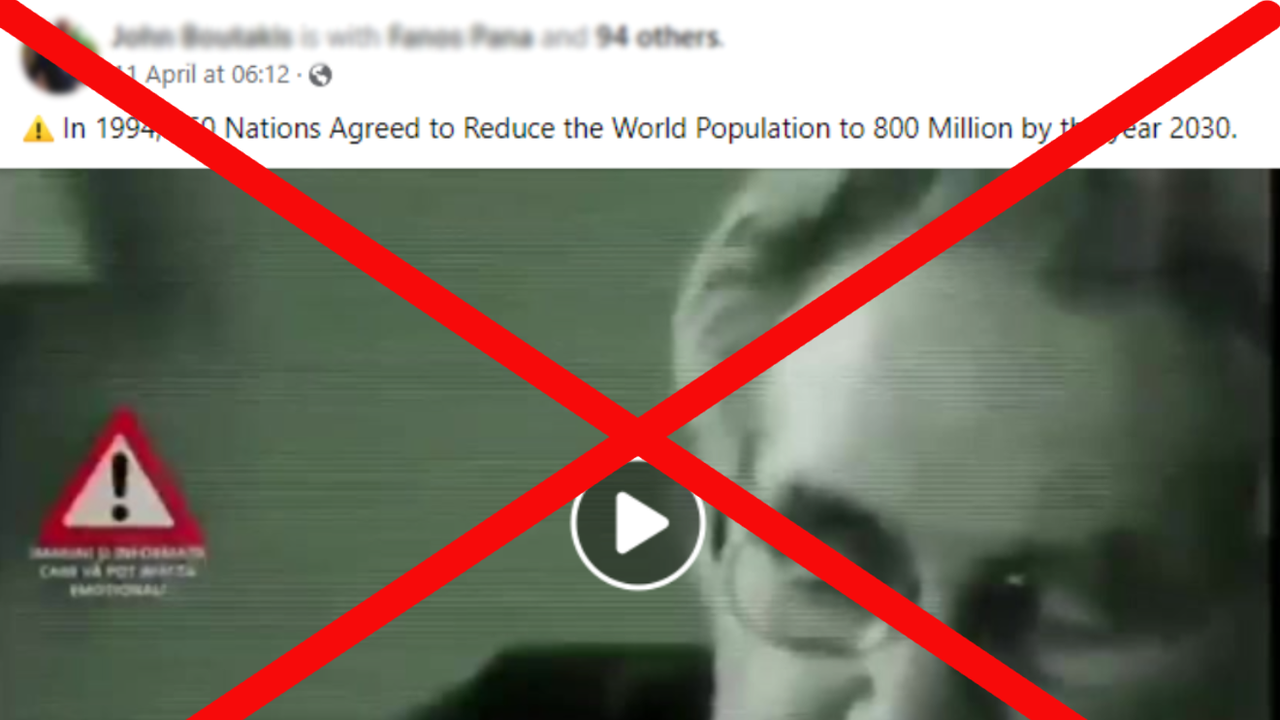WHAT WAS CLAIMED
World leaders at a 1994 United Nations conference agreed to reduce the world population to 800 million by the year 2030.
OUR VERDICT
False. No such agreement exists.
A grainy video spreading on social media declares that leaders at a United Nations (UN) summit three decades ago agreed to cut the global population to 800 million.
This is false. A UN population conference held in 1994 did not result in any such agreement.
Attendees, in fact, agreed to support sustainable population growth and forecasted that the number of humans would rise.
The claim appears in a six-minute video posted on Rumble (archived here), which was shared across social media ahead of a UN meeting to review progress on the 1994 agreement 30 years on.
"In 1994, the world population summit in Cairo, Egypt, had 160 nations participate, where they all agreed that the human population was out of control and must be stopped because the world was running out of resources," an unidentified man with an American accent says.

"An agreement was formed that would mandate a reduction of humans from six billion to 800 million by the year 2030.
"This means finding a method or methods to wipe out nearly 95 per cent of the population. Solutions were discovered, investigated... and have been in full force since."
The man repeats debunked theories about plots to kill humans, including false claims that AIDS was intentionally spread through vaccines and that planes are spraying poisonous "chemtrails" on people.
The video has been spreading in 2024, but has been online since at least 2021.
Anti-globalist conspiracy theorists often allege there are depopulation plots, and they have targeted figures such as billionaire Bill Gates and conservationist Dr Jane Goodall.
The UN's 1994 International Conference on Population and Development (ICPD) in Cairo hosted 179 nations, not 160.
The United Nations Population Fund says the summit resulted in a "Programme of Action" adopted by all participating nations.
The 177-page program does not mention a plan to slash the population, instead referring to "sustainable" growth and "stabilisation."
The chapter on population growth describes the "ultimate goal" as the "improvement of the quality of life of present and future generations".
It says governments should "facilitate" the shift as soon as possible to meet that goal while "fully respecting human rights".
It also forecasted global population would increase from about 5.6 billion in 1994 to 7.9 billion-11.9 billion by 2050.

Dr Caroline Kabiru, a senior researcher at the African Population and Health Research Center who has written about the 1994 conference, says the claim about a depopulation plan is "misguided and false".
"I am not aware of any plans by the UN or other global organisations to reduce the net global population to 800 million," she told AAP FactCheck.
"The Programme of Action ... does not make mention of any demographic targets. In fact, the document highlights the expected growth in population."
Dr Alex Ezeh, a global health professor at Philadelphia's Drexel University, says the claim is "the opposite" of what was agreed at the 1994 conference — that everyone had the right to decide how many children to have and when.
"The ICPD shifted attention away from pursuing demographic targets to meeting the reproductive needs of individuals and couples," Dr Ezeh told AAP FactCheck.
"The claim is false with no single grain of truth, at least as far as the references to ICPD are concerned. "
The Verdict
The claim that world leaders at a 1994 United Nations conference agreed to reduce the world population to 800 million by the year 2030 is false.
The conference did not agree to depopulate the planet but agreed on a program to support sustainable population growth.
Experts told AAP FactCheck the agreement had no population targets and focused on protecting human reproductive rights.
False – The claim is inaccurate.
AAP FactCheck is an accredited member of the International Fact-Checking Network. To keep up with our latest fact checks, follow us on Facebook, Twitter and Instagram.












